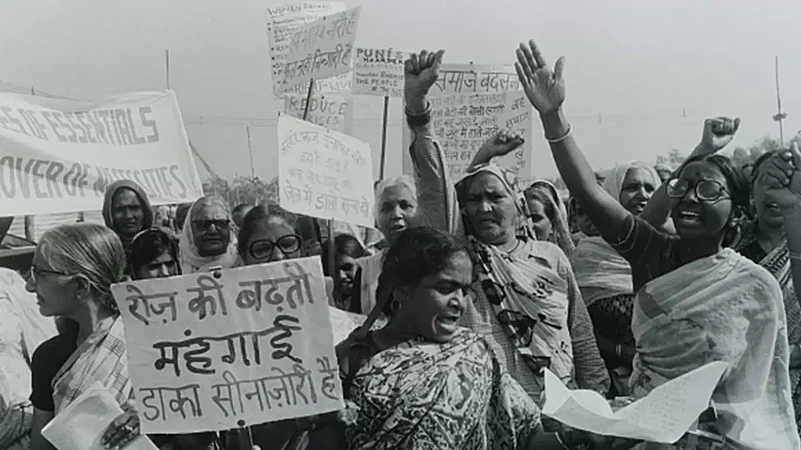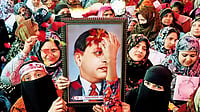Women as an independent, social and political constituency have been in the making in India for few decades now. Early recollections in post-independent India (1970s) begin with public demonstrations by women against price rise. Women were on the streets carrying empty containers, thalis and belan (rolling pin). It was then asked why is price rise an issue concerning only women and the symbolism of carrying a belan reduced women’s presence to the kitchen and the role of a homemaker.
In the 1990s, they were once again on the streets in a big way and this time much more aggressive and assertive for complete prohibition of liquor in the combined state of Andhra Pradesh. As part of this protest, women had not only foregrounded the public sanction for abusive husbands but how domestic violence is sustained not just due to cultural attitudes alone, but also the entire structure of political economy. As part of the protests for prohibition of liquor, they exposed the unholy nexus between the legislators, police, liquor barons and the local mafia. There was a somewhat uncanny, but direct link between state repression and structural violence, and the violations that take place behind the patriarchal walls of privacy. As part of this historic protest, women in the villages also declared their independence from their counterparts in the urban dwellings. They seemingly used violent methods of breaking open liquor shops and burning the country-made liquor that took the lives of their husbands and was also the reason behind the growing medical bills and the pauperisation that compelled them to pawn household items and personal belongings that were otherwise the symbols of femininity that needed protectionism. Women accosted trucks transporting liquor, and got into physical scuffs to force them to turn back from their villages. At one point, state governments were forced to sell liquor in police stations and later introduce a novel system of home delivery in pouches! Trust our rulers for ingenious creativity with regard to devious issues!
Many scholars also lauded the organisational structure of the protests as it was declared free of leadership and hierarchical structures. It was a leaderless protest that could not be contained by arresting a prominent leader, as it often happens with progressive-Left struggles. Every woman was both the leader and an organiser and understood precisely what was at stake. The anti-liqour movement succeeded in compelling the then chief minister, N T Rama Rao, to prohibit liquor and declare Andhra Pradesh a dry state. Of course, only for a couple of years before liquor was back in sale when Chandrababu Naidu took over the reins and re-introduced under the ruse that the state was losing FDI because foreigners—when they came to the state to invest—had to be offered the choicest liquor. A gentle reminder that rulers too can be extremely concerned and compassionate!!
However, the movement succeeded in making prohibition a standing demand in Indian politics and it also demonstrated the possibility and the need for women to emerge as an independent social constituency cutting across caste, class and religion. It foregrounded the need to mobilise women not around families, but around their own set of demands. Today, one can see the impact when regional parties across states are promising free bicycles and sanitary pads for college-going girls, free access to public transport and the demand for prohibition of liquor entering so many other states.
The year 2020 witnessed yet another round of women’s protests when (Muslim) women were out on the streets against the National Register of Citizens (NRC) and the Citizen Amendment Act (CAA). They did an unprecedented sit-in at Shaheen Bagh in Delhi and similar such dharnas at many other places; once again forcing the State to keep the implementation of NRC and CAA on hold. It also raised a number of other questions for the politics of polarisation. It brought in common concerns of love and care that hold families together cutting across religions. It also saw Muslim men yield space to women folk to lead the struggle and become public speakers and one cannot forget the dadis (grannies) of Shaheen Bagh who kept insisting on meeting Modi to ask why the CAA? It was a case of intimacy puncturing the pretention of a muscular State and a masculine leader. It again foregrounded a leaderless struggle that was difficult to contain with arrests and intimidation. It also asked of us as to what happens to the political subjectivity of these protesting women when they retire to the privacy of their homes. Do they still remain figures of subversion? Did their public participation impact domestic spaces to yield more dignity?
This was the case with a host of other protests led by women from the Meira Paibis in Manipur to the half-widows of Kashmir. The fact is that whatever might be the nature of violence, whether it is around caste or religion, it was women who bore the brunt of it through sexual violence in order to dishonor the community and bring it into submission. Women had common concerns cutting across these social divides and it was against this backdrop that one has to assess and understand the significance of the demand for 33 per cent reservations for women in Parliament. It is, in one sense, a culmination of various disparate demands brought together through the demand to recognise the significance of ‘politics of presence’. However, in a society marked by a great degree of social differentiation and ‘graded inequalities’, the culmination never easily amounts to a convenient convergence—especially when the ruling elites champion such a cause that one has to necessarily read between the lines.
India is an anomalous paradox where the political does not easily reinforce the social. In fact, it almost as a rule becomes an equation of trade-off and collective bargain. While one should celebrate the force of social protests that has compelled the political elites to articulate the demand for women’s reservations, it carries the ominous possibility of this political demand overshadowing all other forms of social demands. Representation cannot stand-in for necessary changes on the social and cultural fronts. It gives a false sense of solidity and solidarity. It is well possible that the 33 per cent women work more as a part of a ruling block than for subversive transformation.
If the history of Dalit politics is a signpost for such a dynamic, it is clear that ‘mere’ elections of Dalits through reserved seats have hardly made a difference to the social discrimination and economic dispossession of Dalits. On the contrary, political inclusion of Dalits has served well to push under the carpet the real plight and representation is seen as a misplaced standard to evaluate changing caste dynamics. In fact, the visible Dalit-political ‘mezzanine elites’ reduce, by default, violence against Dalits into exceptions and local aberrations. In the south of the Vindhyas, where the independent Dalit movement has strong roots, it has managed to raise more awareness around issues of recognition and redistribution; though this could never fructify into Dalits coming to power as an independent political formation. Much in contrast, in the north, where Dalits did manage to come to power through the BSP, they barely managed to articulate the social demands of education, land, access to resources and dignity. Political became a compromise to maintain social consensus. The BSP is struggling to find traction in the south because the nature of social demands are much more radical and structural than what a political formation like the BSP can manage to articulate as part of its electoral calculations. Dalit scholar and activist K Laxmi Narayana of the University of Hyderabad, in the course of a personal communication, referred to this pining for political power at the cost of everything else as if it was a ‘master key’ to all other deadlocks. One needs to keep a close watch on this equation, even as we re-evaluate Ambedkar’s strategy of suggesting the significance of political power for the Dalits—even as he chose to resign as a minister in Nehru’s cabinet in protest against the non-implementation of the Hindu Code Bill.
Such an equation and its inherent capacity to mutually cancel out needs to be kept in mind; more so because of the circumstances of the proposal for 33 per cent reservations was brought up in Parliament. It was offered as a ‘compensation’ for the lackadaisical approach with regard to the allegations by the women wrestlers against a sitting BJP MP (who has just been made an election in-charge) and videos of women being paraded naked in Manipur. Clamour for women’s reservations should not be allowed to cloud the struggles of the wrestlers and women in Manipur. ‘Mere’ presence of more women in Parliament is not a solution to the questions wrestlers are raising or the debate over marital rape that the current regime is refusing to legally recognise. We have ‘enough’ women parliamentarians who could have taken a lead, especially those women ministers and parliamentarians, who were seemingly assertive, went silent. The presence of more women is not a guarantee, but it will serve as a reminder to put more pressure to make them do what they promised to represent, if only for the fact that it was the women’s movement in India that was the first to remind us of the successes of leaderless struggles!!
(Views expressed are personal)
Ajay Gudavarthy is associate professor, Jawaharlal Nehru University, New Delhi
(This appeared in the print as '33% Shall Not Cloud Over The 50%)























